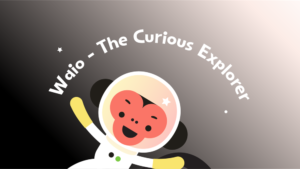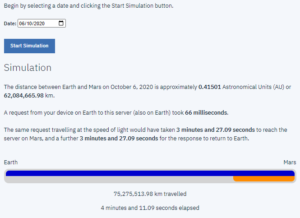Griffith engineering student leader Dominique MacDonald is set to complete a stellar four years of undergraduate studies, including STEM ambassadorships and industry placements, but not before taking her ambitions to new heights as host of the Gold Coast NASA Space Apps Challenge – part of the world’s largest global hackathon.
With 16 months experience as an R&D software developer for a Gold Coast biotech company already under her belt, and a graduate position as a robotics engineer at global mining giant Rio Tinto in her back pocket, the former Griffith Women in Engineering president has left little unaccomplished, turning to space as a new frontier.
Flying solo as lead for the inaugural local event, which she ran in virtual mode on-line from the Gold Coast Health and Knowledge Precinct’s Cohort Innovation Hub (3-4 October), Dominique wasn’t sure what to expect from challenge participants, other than out-of-this world ideas.
“The challenge categories were really broad — observe, inform, sustain, create, confront, and connect, along with the opportunity for teams to invent their own challenge, so I really wasn’t sure what ideas would emerge from our teams,” Dominique said.
“We ended up with a small group of three teams who each went in different creative directions – the whole point of the challenge – which has been running internationally since 2012, and uses NASA’s open data to build innovative solutions to problems faced both in space and on earth.”

NASA Space Apps Challenge Gold Coast Mascot concept
Setting out to better inform young children about space and engage them in sustaining life on earth, one team conceived a mascot called Waio (pronounced Why? Oh!), a curious monkey explorer, which they proposed would intuitively anticipate and answer children’s questions about space, akin to a Siri, Alexa or Google Assistant.
With a Mars manned mission moving closer into sight, another team responded to the challenge of creating an artwork inspired by the red planet, turning magnetometer data from the Lunar Prospector mission into a 30-second soundscape, including data captured of sun pulses as the rhythm.

NASA Space Apps Challenge Gold Coast Communication simulation concept
The final participant took a technical path, with an application that simulates calculations of the variable length of time taken for a message to relay from Earth to Mars, or vice versa, displayed as a loading bar.
“Time to communicate from Earth to Mars varies dependant on the orbits of both planets around the sun and is also affected by the position of our international space station satellite as it orbits around the earth,” Dominique explained.
“This was a cool idea to demonstrate the significant communication challenges that will confront any mission to Mars.
“Overall, it was good to make connections between the teams, even if we had to rely on Zoom calls to be as collaborative as we could over the intense, 48 hour challenge period, and two of the local teams now progress to the global round of judging.”
Capping her four years at Griffith, which also included a Vacation Scholar internship with the CSIRO’s Data 61, roles on Engineering School Committees, and volunteering with the Australian Youth Aerospace Association and Women in AI groups, Dominique is completing her undergraduate thesis, exploring how to better distinguish a foetal heartbeat from the pregnant mother’s heartbeat.
“My time at Griffith has been so much more than I could have imagined,” Dominique said.
“I walked into the engineering degree unsure of what engineers even do, so it has been an incredible learning journey for me.”
“I am so thankful to all the lecturers, demonstrators, and even my fellow undergrads for always fostering such a supportive environment — without their support, I would not be where I am today.
“More than anything, I’m excited to see where my graduate role in Robotics Engineering will take me.
“It will be interesting seeing the implementation of robotics and automation on such a large scale, particularly as I have only ever seen smaller-scaled robotics in the field.”
